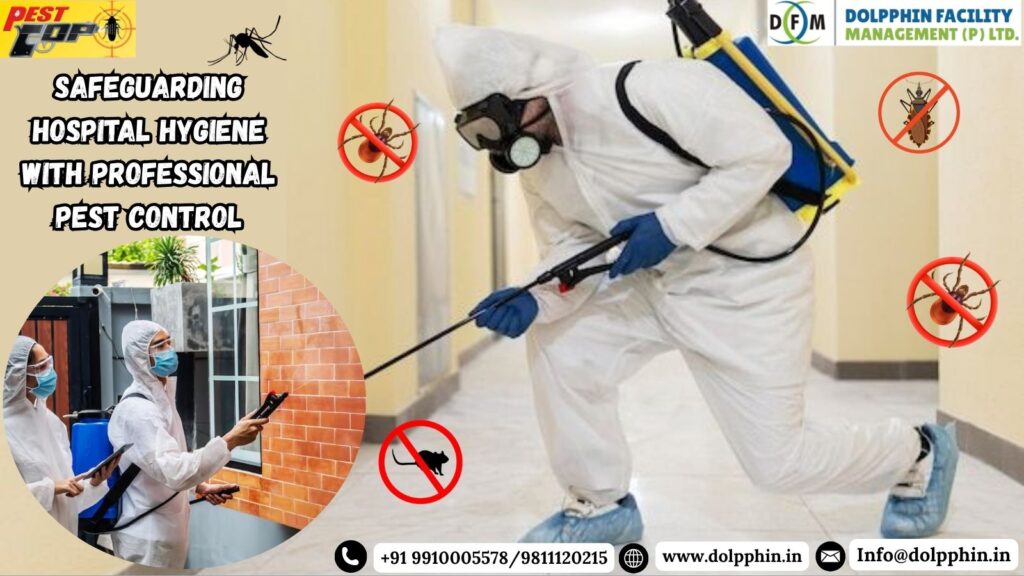
Breaking Report: Hospitals Across the Nation Battle Silent Hygiene Threat—Pests.
Delhi, June 2025 — Recent examinations of public and commercial hospitals uncovered a serious problem: hidden insect infestations. These undesirable intruders—cockroaches, rats, and flies—threaten cleanliness standards and raise the risk of infection in healthcare facilities.
Dolpphin Facility Management Pvt. Ltd. has been in the forefront of hospital pest control solutions for more than two decades. From experience, we know that sterilized walls and spotless floors are insufficient. The true threat is frequently found in drains, ductwork, kitchens, and utility shafts.
So, how can hospitals maintain high-quality sanitary standards? The solution is a competent, systematic, and environmentally friendly pest management technique.
Let’s look at how pests degrade cleanliness—and how strategic pest management might help restore it.
1. Understanding the Link. Between Pests and Hospital Hygiene
Hospitals are high-risk environments for disease control. However, bugs complicate matters. Cockroaches, flies, and rodents carry pathogens like E. coli, Salmonella, and Staphylococcus aureus, which can easily contaminate sterile areas and equipment.
In fact, pests are a direct cause of Healthcare-Associated Infections (HAIs). Whether it’s a cockroach under the sink or a rat in the utility shaft, every infestation is a potential medical emergency.
Maintaining hygiene in hospitals is more than simply about beauty; it is a question of life, health, and safety.
2. Identification of Common Pests Found in Hospitals
Hospitals can attract a variety of pests, depending on their layout and management procedures. The most frequent are:
Cockroaches thrive in warm, dark environments such as storerooms, drains, and ducts. They transmit allergies and infections.
Rodents chew through wires, munch on supplies, and deposit disease-carrying droppings.
Flies – Common near garbage cans or kitchens, transmitting pathogens with each landing.
Mosquitoes- breed in stagnant water and transmit diseases such as dengue and malaria.
Bed bugs and ants – irritate the skin and cause agony for patients, lowering the hospital’s repute.
Identifying these concerns early is the first step toward establishing effective hospital pest management techniques.
3. High-Risk Areas in Hospitals That Need Targeted Pest Control
Pest activity varies by hospital zone. Certain locations are particularly vulnerable and require special attention:
➤ Operating theatres and intensive care units
Even one bug can contaminate a sterile medical field.
➤ Patient Wards
Unwell people have a weakened immune system, making any exposure dangerous.
➤ Hospital Kitchens and Food Storage.
Food sources can attract pests and transmit contamination quickly.
➤ Garbage areas and drains.
Flies, mosquitoes, and rats thrive here.
➤ Public waiting areas and corridors.
These places are frequently overlooked but serve as insect entry points, allowing infestations to spread throughout the facility.
4. The best pest control strategies for hospitals.
At Dolpphin Facility Management Pvt. Ltd., we take a tailored, hospital-friendly approach to patient safety and infection control.
✔ Integrated Pest Management (IPM)
is a non-toxic strategy that involves trapping, monitoring, sealing, and targeted treatment.
✔ Odorless and eco-friendly chemicals.
We only utilize pest control products that are WHO and NABH approved and safe for indoor usage, particularly around patients.
✔ Targeted disinfection and fogging
Especially in waste areas, kitchens, and basements, to eliminate concealed nests and breeding grounds.
5. Ensure Staff and Patient Safety During Pest Control.
Our strategy prioritizes patient and staff safety:
✔Treatments are performed during off-peak hours to minimize inconvenience.
✔For indoor locations, use gel-based, odorless solutions.
✔Fogging ensures the sealed packing of food and medicine.
✔Throughout the service, proper signage and communication protocols are followed.
Our skilled personnel adhere to hospital SOPs, wear ID cards, and are outfitted with protective equipment. All therapies meet ISO 9001:2008 and hospital infection control requirements.
Conclusion: Cleanliness is the first step toward protecting your health
Pest control in hospitals is not a luxury; it is a need. Even a tiny infestation in a healing environment can cause serious health problems. Hospitals can protect patients, workers, and leave a trusting legacy by proactively addressing pest problems.
Dolpphin Facility Management Pvt. Ltd. is happy to work with hospitals around India to deliver safe, accredited, and effective pest control solutions. If your facility is ready to take hygiene to the next level, now is the time to act.
🧼 In healthcare, prevention is not only better than cure, but it is the cure.